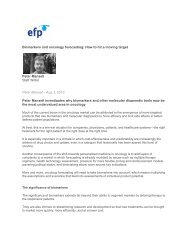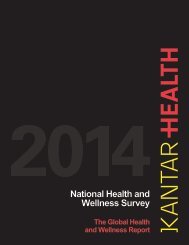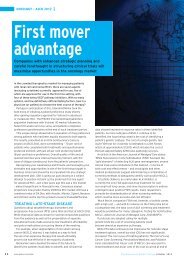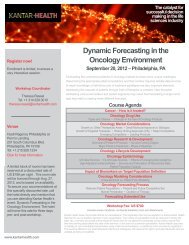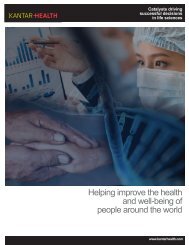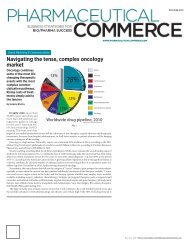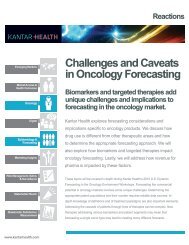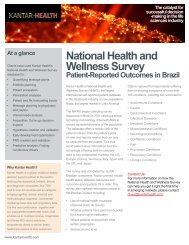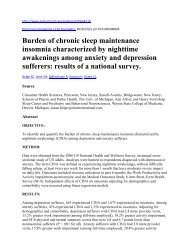Impact of Medication Adherence on Work ... - Kantar Health
Impact of Medication Adherence on Work ... - Kantar Health
Impact of Medication Adherence on Work ... - Kantar Health
Create successful ePaper yourself
Turn your PDF publications into a flip-book with our unique Google optimized e-Paper software.
n Wagner • Lau • Frech-Tamas • Gupta<br />
dem<strong>on</strong>strated for other chr<strong>on</strong>ic diseases, including asthma<br />
41 and depressi<strong>on</strong>. 42 However, due to the recognized<br />
symptomatic nature <str<strong>on</strong>g>of</str<strong>on</strong>g> these diseases, findings observed<br />
for these chr<strong>on</strong>ic illnesses may not be generalizable to<br />
hypertensi<strong>on</strong>, which is recognized as an asymptomatic<br />
disease for most patients.<br />
While our study provides a valuable c<strong>on</strong>tributi<strong>on</strong> to the<br />
antihypertensive medicati<strong>on</strong> adherence literature, several<br />
limitati<strong>on</strong>s are important to c<strong>on</strong>sider when interpreting<br />
our study’s findings. Our study was performed <strong>on</strong> a sample<br />
<str<strong>on</strong>g>of</str<strong>on</strong>g> subjects with hypertensi<strong>on</strong> who reported full-time<br />
employment, and thus is representative <str<strong>on</strong>g>of</str<strong>on</strong>g> <strong>on</strong>ly those employed<br />
full time; there may be subject characteristics that<br />
are associated with the likelihood <str<strong>on</strong>g>of</str<strong>on</strong>g> employment, medicati<strong>on</strong><br />
adherence, and/or low productivity that resulted in<br />
populati<strong>on</strong> selecti<strong>on</strong> bias and/or c<strong>on</strong>founding. However,<br />
the multivariate regressi<strong>on</strong> used for the productivity analysis<br />
should have reduced the effects <str<strong>on</strong>g>of</str<strong>on</strong>g> other factors for<br />
those covariates that were available for analysis. As our<br />
study sample was identified via an Internet-based survey,<br />
our populati<strong>on</strong> may not be representative <str<strong>on</strong>g>of</str<strong>on</strong>g> the general<br />
US populati<strong>on</strong>; due to the method <str<strong>on</strong>g>of</str<strong>on</strong>g> survey administrati<strong>on</strong><br />
and the full-time employment status <str<strong>on</strong>g>of</str<strong>on</strong>g> our sample<br />
it is plausible that our study sample represented pers<strong>on</strong>s<br />
with higher income, educati<strong>on</strong>, and socioec<strong>on</strong>omic status<br />
than the US populati<strong>on</strong> as a whole. However, our study’s<br />
estimate <str<strong>on</strong>g>of</str<strong>on</strong>g> the prevalence <str<strong>on</strong>g>of</str<strong>on</strong>g> hypertensi<strong>on</strong> is c<strong>on</strong>sistent<br />
with published estimates for a similar time period. 4 Nevertheless,<br />
for these reas<strong>on</strong>s, our study’s findings may<br />
not be generalizable to all hypertensive pers<strong>on</strong>s across<br />
the United States. Some important informati<strong>on</strong> was not<br />
available for inclusi<strong>on</strong> as covariates, including durati<strong>on</strong><br />
<str<strong>on</strong>g>of</str<strong>on</strong>g> hypertensi<strong>on</strong>, durati<strong>on</strong> <str<strong>on</strong>g>of</str<strong>on</strong>g> medicati<strong>on</strong> use, medicati<strong>on</strong><br />
acquisiti<strong>on</strong> cost, insurance status, subject body mass index,<br />
and number and specific classes <str<strong>on</strong>g>of</str<strong>on</strong>g> antihypertensive<br />
medicati<strong>on</strong>s prescribed. In additi<strong>on</strong>, while antihypertensive<br />
therapy adherence was assessed, the reas<strong>on</strong>s for antihypertensive<br />
medicati<strong>on</strong> n<strong>on</strong>adherence are unknown.<br />
Our study utilized self-reported data for all measures, including<br />
BP measurements, productivity, and self-reported<br />
antihypertensive agent use. No objective measurements<br />
<str<strong>on</strong>g>of</str<strong>on</strong>g> BP and/or data to validate patient self-reported medicati<strong>on</strong><br />
acquisiti<strong>on</strong> and c<strong>on</strong>sumpti<strong>on</strong> (such as prescripti<strong>on</strong><br />
claims informati<strong>on</strong>) were available. While prescripti<strong>on</strong><br />
claims data are usually c<strong>on</strong>sidered the most accurate data<br />
source to enable assessment <str<strong>on</strong>g>of</str<strong>on</strong>g> medicati<strong>on</strong> adherence, the<br />
validated Morisky scale has been used across therapeutic<br />
areas as a proxy to estimate medicati<strong>on</strong> adherence, 15-19 although<br />
admittedly, the MMAS may be somewhat less sensitive<br />
and is subject to patient self-report bias. Previous<br />
research has generally supported the validity <str<strong>on</strong>g>of</str<strong>on</strong>g> subject<br />
self-report <str<strong>on</strong>g>of</str<strong>on</strong>g> blood pressure and/or hypertensive status<br />
in various settings, with self-report correctly identifying<br />
the majority <str<strong>on</strong>g>of</str<strong>on</strong>g> actual hypertensive pers<strong>on</strong>s, with higher<br />
specificity than sensitivity generally reported. 43-48 Previous<br />
research has also supported the use <str<strong>on</strong>g>of</str<strong>on</strong>g> subject self report<br />
<str<strong>on</strong>g>of</str<strong>on</strong>g> absenteeism based <strong>on</strong> validati<strong>on</strong> using administrative<br />
data. 49 However, the WPAI is not c<strong>on</strong>diti<strong>on</strong>-specific, and<br />
productivity estimates may also reflect the impact <str<strong>on</strong>g>of</str<strong>on</strong>g> other<br />
comorbid c<strong>on</strong>diti<strong>on</strong>s (although these were included<br />
as covariates in multivariate analyses) as well as other<br />
external unmeasured factors. Finally, it is possible that<br />
our study’s findings as related to antihypertensive medicati<strong>on</strong><br />
adherence may also reflect adherence to other<br />
classes <str<strong>on</strong>g>of</str<strong>on</strong>g> medicati<strong>on</strong>s, as patients might be expected to<br />
have similar adherence results for medicati<strong>on</strong>s for other<br />
comorbid c<strong>on</strong>diti<strong>on</strong>s; this may, in part, c<strong>on</strong>tribute to the<br />
relati<strong>on</strong>ship between productivity and antihypertensive<br />
medicati<strong>on</strong> compliance.<br />
CONCLUSIONS<br />
A significant reducti<strong>on</strong> in work productivity was reported<br />
by participants who were classified as low adherence<br />
with regard to their antihypertensive treatment,<br />
primarily associated with productivity while at work (eg,<br />
presenteeism). Stage 2 hypertensive resp<strong>on</strong>dents reported<br />
significantly more work productivity impairment than<br />
resp<strong>on</strong>dents with less severe stages <str<strong>on</strong>g>of</str<strong>on</strong>g> hypertensi<strong>on</strong>, and<br />
the number <str<strong>on</strong>g>of</str<strong>on</strong>g> comorbidities was also significantly associated<br />
with work productivity impairment. Our findings<br />
suggest an associati<strong>on</strong> between low adherence to<br />
antihypertensive treatment and poorer outcomes. Initiatives<br />
targeting improved adherence to medicati<strong>on</strong>s and<br />
improved BP c<strong>on</strong>trol am<strong>on</strong>g patients with hypertensi<strong>on</strong><br />
may present ec<strong>on</strong>omic opportunities for employers by<br />
impacting work productivity.<br />
Acknowledgment<br />
Jenifer Wogen, MS, MedMentis C<strong>on</strong>sulting, LLC, provided medical<br />
writing and editorial services in support <str<strong>on</strong>g>of</str<strong>on</strong>g> this manuscript, and received<br />
financial compensati<strong>on</strong> from Novartis Pharmaceuticals Corporati<strong>on</strong>.<br />
Author Affiliati<strong>on</strong>s: From Novartis Pharmaceuticals Corporati<strong>on</strong><br />
(HL, FF-T), East Hanover, NJ; <strong>Kantar</strong> <strong>Health</strong> (SW, SG), Princet<strong>on</strong>, NJ<br />
(formerly known as C<strong>on</strong>sumer <strong>Health</strong> Sciences).<br />
Funding Source: Novartis Pharmaceuticals Corporati<strong>on</strong>.<br />
Author Disclosures: Dr Frech-Tamas and Ms Lau report employment<br />
with Novartis Pharmaceuticals Corporati<strong>on</strong>, the funder <str<strong>on</strong>g>of</str<strong>on</strong>g> the study,<br />
and stock ownership in the company. The other authors (SW, SG) report<br />
no relati<strong>on</strong>ship or financial interest with any entity that would pose a<br />
c<strong>on</strong>flict <str<strong>on</strong>g>of</str<strong>on</strong>g> interest with the subject matter <str<strong>on</strong>g>of</str<strong>on</strong>g> this article.<br />
Authorship Informati<strong>on</strong>: C<strong>on</strong>cept and design (SW, HL, FF-T,<br />
SG); acquisiti<strong>on</strong> <str<strong>on</strong>g>of</str<strong>on</strong>g> data (SW); analysis and interpretati<strong>on</strong> <str<strong>on</strong>g>of</str<strong>on</strong>g> data (SW,<br />
HL, FF-T, SG); drafting <str<strong>on</strong>g>of</str<strong>on</strong>g> the manuscript (HL, FF-T); critical revisi<strong>on</strong> <str<strong>on</strong>g>of</str<strong>on</strong>g><br />
the manuscript for important intellectual c<strong>on</strong>tent (SW, HL, FF-T, SG);<br />
e94 The American Journal <str<strong>on</strong>g>of</str<strong>on</strong>g> Pharmacy Benefits • July/August 2012<br />
www.ajpblive.com



